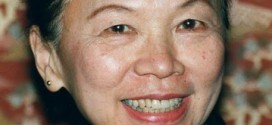By Suchi Rudra
 Since Sarah Shabbir became a U.S. Foreign Service Officer at the age of 23 back in 2005, she’s already been posted overseas twice, first based in Abu Dhabi for two years as Vice Consul at the American Embassy, and then 2 years in Hong Kong, where she was Consul at the U.S. Consulate General. Asian Fortune spoke with Sarah about dragon boats, bed sheets and her penchant for difficult languages.
Since Sarah Shabbir became a U.S. Foreign Service Officer at the age of 23 back in 2005, she’s already been posted overseas twice, first based in Abu Dhabi for two years as Vice Consul at the American Embassy, and then 2 years in Hong Kong, where she was Consul at the U.S. Consulate General. Asian Fortune spoke with Sarah about dragon boats, bed sheets and her penchant for difficult languages.
AF: What do you think about all the relocating and traveling that is a big part of your job?
When I joined the U.S. Department of State as a Foreign Service Officer, I signed up knowing that I could be assigned to any American embassy or consulate in the world. I also knew that I would be asked to move from one posting to another every two or three years. That said, moving from one country to another is certainly not a new phenomenon in my family. For example, my father left India when he was 20 to pursue higher education in engineering in the United Kingdom in the 1960s, moved to Canada to gain work experience after graduating, and later immigrated to the United States. I can even go back another generation to show that travel is in my blood. My grandfather was a professor of engineering at a prestigious university in Hyderabad, India and took an assignment as a visiting professor at the University of Baghdad in the 1960s. This was when the world was a different place than it is now. These cross-cultural exchanges enrich not only the people involved, but their whole community at home.
AF: What are a few items you’ve got to have when you pack for an assignment overseas?
I have only one must-have item. And it’s kind of odd. I travel with my own bed sheets. Usually we travel with just two suitcases, and the rest of our things come by air freight or sea freight. Both of those means of transport can take several weeks, sometimes months, and I just can’t sleep as well on the temporary bed sheets provided to us while we wait!
AF: What is it like to be an Asian American woman in the U.S. government?
Like other U.S. government agencies, the State Department is super committed to diversity and continues to improve its recruiting to make sure the diplomats we send abroad “look like America,” which is to say American diplomats are a diverse group of people. When I’m posted overseas, I think being an Asian American who represents the United States allows me to give people in other countries a fuller picture of the multiculturalism we have in America. I often tell people that my family history is very typical in America. I think most Americans can find an immigration story if they go back a couple generations.
AF: What are a couple of key issues or projects that you are involved in currently?
Right now, I’m working from the State Department’s headquarters in Washington, D.C. in the field of public diplomacy, which focuses on people-to-people connections between America and the rest of the world. Specifically, I cover all of South Asia. I work on providing support on outreach through social media, written materials, video and the like. My office also supports the 820 “American Spaces” we have in 169 countries all over the globe. These cultural outposts are usually small libraries where people can gather to connect to resources online, study English and learn more about America and its values.
AF: You’re a board member of the U.S. Department of State’s Asian American Foreign Affairs Association. What’s the organization all about?
The State Department has a number of affinity groups to help strengthen and promote diversity within the organization and one of them is the Asian American Foreign Affairs Association. We have more than 500 members, and we are open to anyone at the State Department with an interest in Asian American issues. May was a particularly busy month for us because it was Asian American and Pacific Islander Heritage Month. We had a talk by the Senator Mazie Hirono from Hawaii, a speech by World Bank president Dr. Jim Yong Kim, a talk by Michelle Kwan, and cultural performances and networking opportunities–and also the dragon boat festival, where we won a bronze in our division!
AF: Congratulations! And you are actually the founder and captain of the first dragon boat team for State Department employees who are based in Washington, D.C. How did that happen?
When I was posted to U.S. Consulate General in Hong Kong, I joined the consulate’s dragon boat team on a whim. I didn’t quite know what to expect. I don’t consider myself an athlete–I’m just someone who enjoys team activities. I like that dragon boating isn’t about being the strongest or fastest—it’s about working as a team. I found out that although I’m not musically talented at all, I can at least keep a beat when it comes to drumming at the front of a dragon boat!
AF: How long does a dragon boat race last?
They are very short. I like to say dragon boat racing is a sprint, not a marathon. The races are either 250 meters or 500 meters and teams can cover 250 meters in about 90 seconds. There are longer races, but I have not done those.
AF: What’s an intriguing film you’ve seen recently?
I recently went to a screening of “Girl Rising.” It’s a film about nine girls from different parts of the world telling their stories about how education helped them break the cycle of poverty, poor health, and abuse. Each girl in the film was paired with a writer from her own country who helped capture her real life experiences into a powerful narrative. I think we’ll see more and more that this type of storytelling, backed with facts, has the power to effect change on an individual and societal level.
AF: What book are you reading right now?
A David Sedaris book! I wish I had the ability for humor writing.
AF: Which languages do you speak? Which language do you want to learn next?
I grew up bilingual, speaking Urdu at home and English at school. In college, I studied Arabic, which was part of the reason I was assigned to the American Embassy in Abu Dhabi, United Arab Emirates for my first posting. I was later assigned to a job requiring Mandarin Chinese at the U.S. Consulate General in Hong Kong, even though the local language there is Cantonese, so I studied Mandarin for a year at the Foreign Service Institute. I studied a bit of Cantonese while living in Hong Kong, but my Mandarin is much better. If I were to choose a new language to study, it would be Spanish. In addition to being able to communicate with people in South America and Central America, it’s just so useful at home in the United States now. Plus, kids already think I look like a grown-up version of Dora the Explorer!
 Asian Fortune Your source for all things Asian American
Asian Fortune Your source for all things Asian American



